BMP4005 Information Systems: Big Data Analysis, Challenges, Support
VerifiedAdded on 2023/06/08
|8
|1959
|421
Report
AI Summary
This report provides a detailed analysis of big data within the context of information systems. It begins by defining big data and outlining its key characteristics, including variety, volume, value, velocity, volatility, visualization, and veracity. The report then delves into the challenges associated with big data analytics, such as the lack of proper understanding of complex data, information security concerns, and the integration of data from various sources. Various techniques currently available for analyzing big data are discussed, including statistics, A/B testing, and machine learning. Furthermore, the report explores how big data technology can support businesses by improving internal efficiencies, automating decision-making processes, revealing hidden patterns, and facilitating the creation of new products and services. The report concludes with real-world examples of companies leveraging big data technologies for competitive advantage.
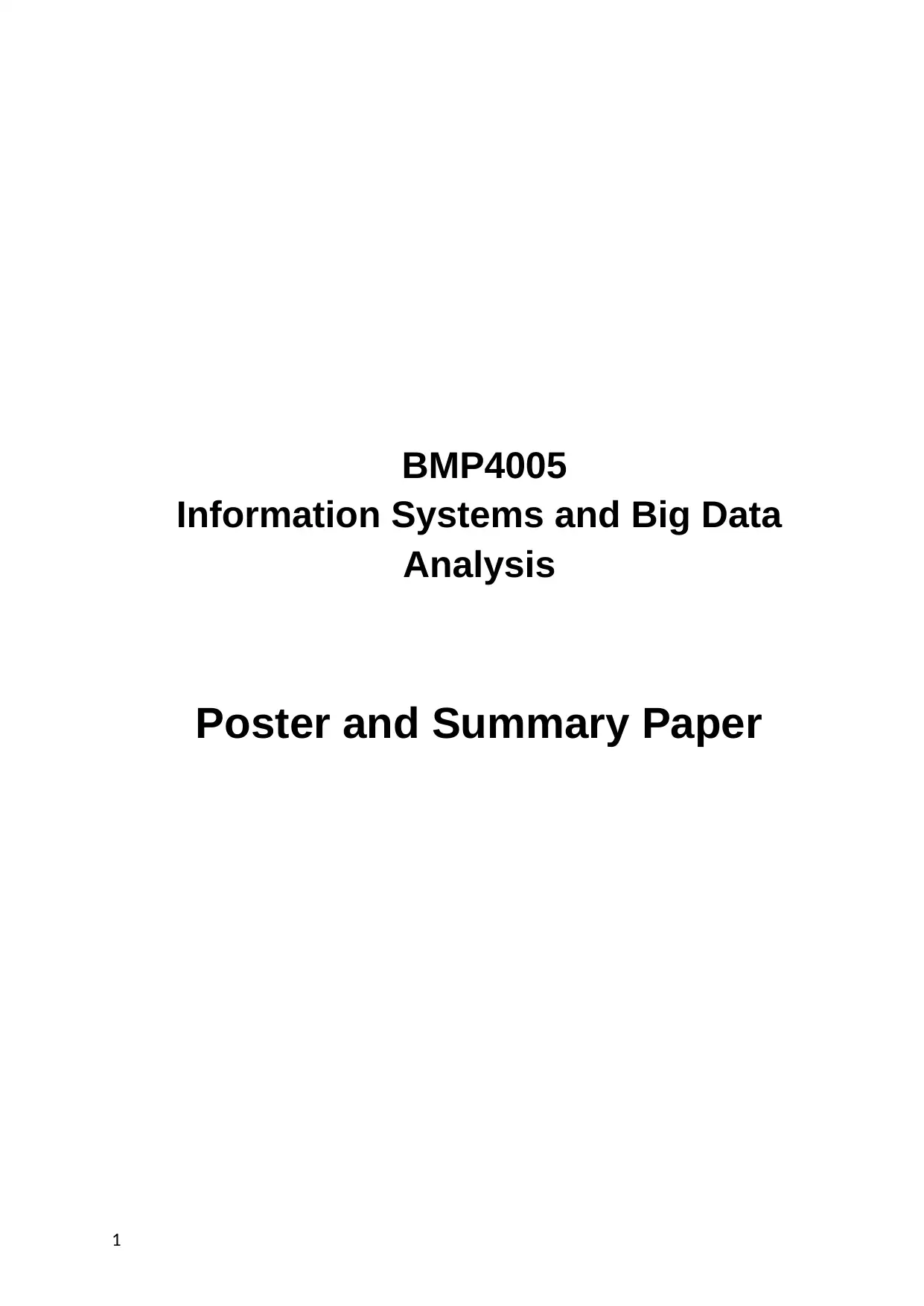
BMP4005
Information Systems and Big Data
Analysis
Poster and Summary Paper
1
Information Systems and Big Data
Analysis
Poster and Summary Paper
1
Paraphrase This Document
Need a fresh take? Get an instant paraphrase of this document with our AI Paraphraser
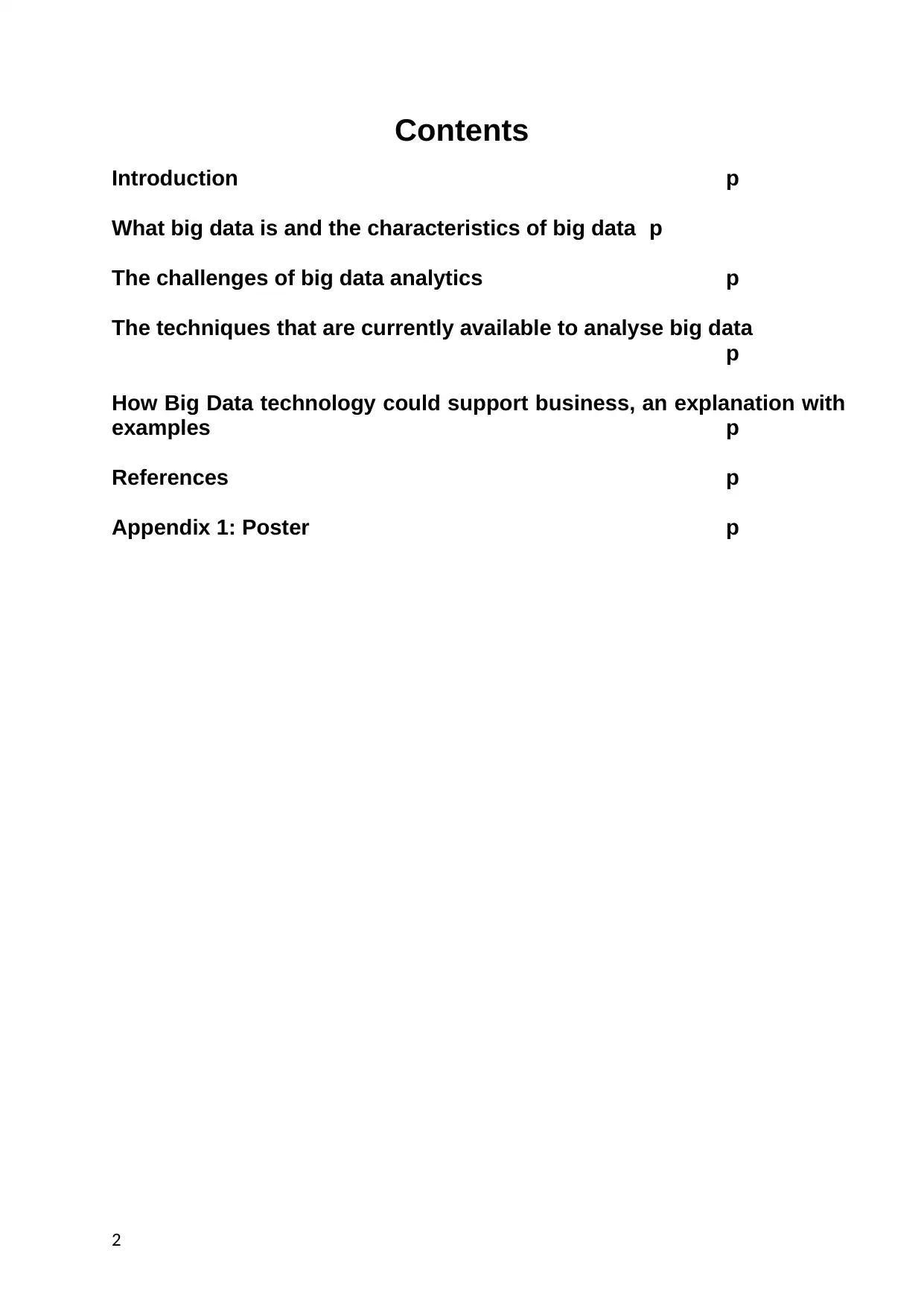
Contents
Introduction p
What big data is and the characteristics of big data p
The challenges of big data analytics p
The techniques that are currently available to analyse big data
p
How Big Data technology could support business, an explanation with
examples p
References p
Appendix 1: Poster p
2
Introduction p
What big data is and the characteristics of big data p
The challenges of big data analytics p
The techniques that are currently available to analyse big data
p
How Big Data technology could support business, an explanation with
examples p
References p
Appendix 1: Poster p
2
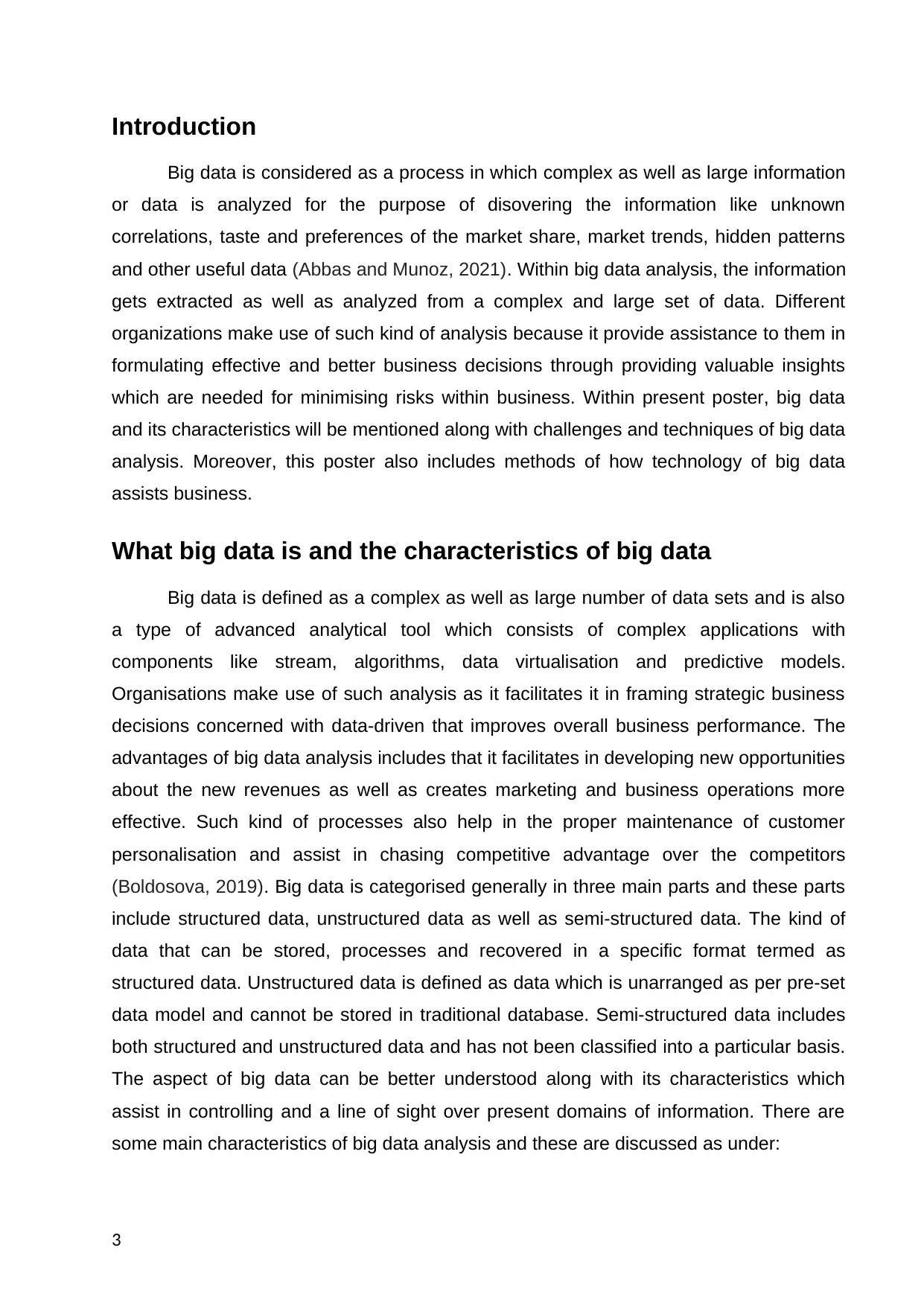
Introduction
Big data is considered as a process in which complex as well as large information
or data is analyzed for the purpose of disovering the information like unknown
correlations, taste and preferences of the market share, market trends, hidden patterns
and other useful data (Abbas and Munoz, 2021). Within big data analysis, the information
gets extracted as well as analyzed from a complex and large set of data. Different
organizations make use of such kind of analysis because it provide assistance to them in
formulating effective and better business decisions through providing valuable insights
which are needed for minimising risks within business. Within present poster, big data
and its characteristics will be mentioned along with challenges and techniques of big data
analysis. Moreover, this poster also includes methods of how technology of big data
assists business.
What big data is and the characteristics of big data
Big data is defined as a complex as well as large number of data sets and is also
a type of advanced analytical tool which consists of complex applications with
components like stream, algorithms, data virtualisation and predictive models.
Organisations make use of such analysis as it facilitates it in framing strategic business
decisions concerned with data-driven that improves overall business performance. The
advantages of big data analysis includes that it facilitates in developing new opportunities
about the new revenues as well as creates marketing and business operations more
effective. Such kind of processes also help in the proper maintenance of customer
personalisation and assist in chasing competitive advantage over the competitors
(Boldosova, 2019). Big data is categorised generally in three main parts and these parts
include structured data, unstructured data as well as semi-structured data. The kind of
data that can be stored, processes and recovered in a specific format termed as
structured data. Unstructured data is defined as data which is unarranged as per pre-set
data model and cannot be stored in traditional database. Semi-structured data includes
both structured and unstructured data and has not been classified into a particular basis.
The aspect of big data can be better understood along with its characteristics which
assist in controlling and a line of sight over present domains of information. There are
some main characteristics of big data analysis and these are discussed as under:
3
Big data is considered as a process in which complex as well as large information
or data is analyzed for the purpose of disovering the information like unknown
correlations, taste and preferences of the market share, market trends, hidden patterns
and other useful data (Abbas and Munoz, 2021). Within big data analysis, the information
gets extracted as well as analyzed from a complex and large set of data. Different
organizations make use of such kind of analysis because it provide assistance to them in
formulating effective and better business decisions through providing valuable insights
which are needed for minimising risks within business. Within present poster, big data
and its characteristics will be mentioned along with challenges and techniques of big data
analysis. Moreover, this poster also includes methods of how technology of big data
assists business.
What big data is and the characteristics of big data
Big data is defined as a complex as well as large number of data sets and is also
a type of advanced analytical tool which consists of complex applications with
components like stream, algorithms, data virtualisation and predictive models.
Organisations make use of such analysis as it facilitates it in framing strategic business
decisions concerned with data-driven that improves overall business performance. The
advantages of big data analysis includes that it facilitates in developing new opportunities
about the new revenues as well as creates marketing and business operations more
effective. Such kind of processes also help in the proper maintenance of customer
personalisation and assist in chasing competitive advantage over the competitors
(Boldosova, 2019). Big data is categorised generally in three main parts and these parts
include structured data, unstructured data as well as semi-structured data. The kind of
data that can be stored, processes and recovered in a specific format termed as
structured data. Unstructured data is defined as data which is unarranged as per pre-set
data model and cannot be stored in traditional database. Semi-structured data includes
both structured and unstructured data and has not been classified into a particular basis.
The aspect of big data can be better understood along with its characteristics which
assist in controlling and a line of sight over present domains of information. There are
some main characteristics of big data analysis and these are discussed as under:
3
⊘ This is a preview!⊘
Do you want full access?
Subscribe today to unlock all pages.

Trusted by 1+ million students worldwide
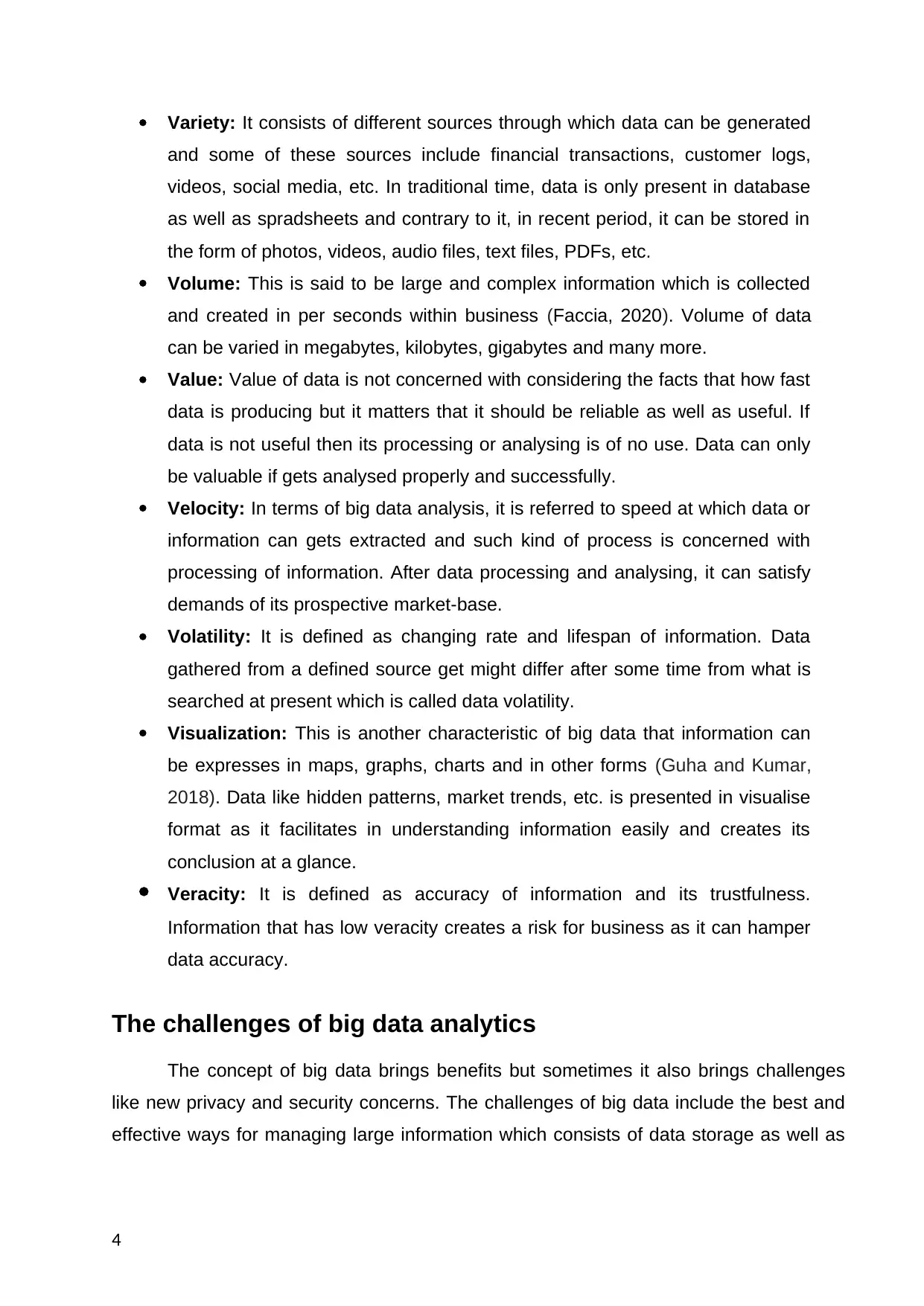
Variety: It consists of different sources through which data can be generated
and some of these sources include financial transactions, customer logs,
videos, social media, etc. In traditional time, data is only present in database
as well as spradsheets and contrary to it, in recent period, it can be stored in
the form of photos, videos, audio files, text files, PDFs, etc.
Volume: This is said to be large and complex information which is collected
and created in per seconds within business (Faccia, 2020). Volume of data
can be varied in megabytes, kilobytes, gigabytes and many more.
Value: Value of data is not concerned with considering the facts that how fast
data is producing but it matters that it should be reliable as well as useful. If
data is not useful then its processing or analysing is of no use. Data can only
be valuable if gets analysed properly and successfully.
Velocity: In terms of big data analysis, it is referred to speed at which data or
information can gets extracted and such kind of process is concerned with
processing of information. After data processing and analysing, it can satisfy
demands of its prospective market-base.
Volatility: It is defined as changing rate and lifespan of information. Data
gathered from a defined source get might differ after some time from what is
searched at present which is called data volatility.
Visualization: This is another characteristic of big data that information can
be expresses in maps, graphs, charts and in other forms (Guha and Kumar,
2018). Data like hidden patterns, market trends, etc. is presented in visualise
format as it facilitates in understanding information easily and creates its
conclusion at a glance.
Veracity: It is defined as accuracy of information and its trustfulness.
Information that has low veracity creates a risk for business as it can hamper
data accuracy.
The challenges of big data analytics
The concept of big data brings benefits but sometimes it also brings challenges
like new privacy and security concerns. The challenges of big data include the best and
effective ways for managing large information which consists of data storage as well as
4
and some of these sources include financial transactions, customer logs,
videos, social media, etc. In traditional time, data is only present in database
as well as spradsheets and contrary to it, in recent period, it can be stored in
the form of photos, videos, audio files, text files, PDFs, etc.
Volume: This is said to be large and complex information which is collected
and created in per seconds within business (Faccia, 2020). Volume of data
can be varied in megabytes, kilobytes, gigabytes and many more.
Value: Value of data is not concerned with considering the facts that how fast
data is producing but it matters that it should be reliable as well as useful. If
data is not useful then its processing or analysing is of no use. Data can only
be valuable if gets analysed properly and successfully.
Velocity: In terms of big data analysis, it is referred to speed at which data or
information can gets extracted and such kind of process is concerned with
processing of information. After data processing and analysing, it can satisfy
demands of its prospective market-base.
Volatility: It is defined as changing rate and lifespan of information. Data
gathered from a defined source get might differ after some time from what is
searched at present which is called data volatility.
Visualization: This is another characteristic of big data that information can
be expresses in maps, graphs, charts and in other forms (Guha and Kumar,
2018). Data like hidden patterns, market trends, etc. is presented in visualise
format as it facilitates in understanding information easily and creates its
conclusion at a glance.
Veracity: It is defined as accuracy of information and its trustfulness.
Information that has low veracity creates a risk for business as it can hamper
data accuracy.
The challenges of big data analytics
The concept of big data brings benefits but sometimes it also brings challenges
like new privacy and security concerns. The challenges of big data include the best and
effective ways for managing large information which consists of data storage as well as
4
Paraphrase This Document
Need a fresh take? Get an instant paraphrase of this document with our AI Paraphraser
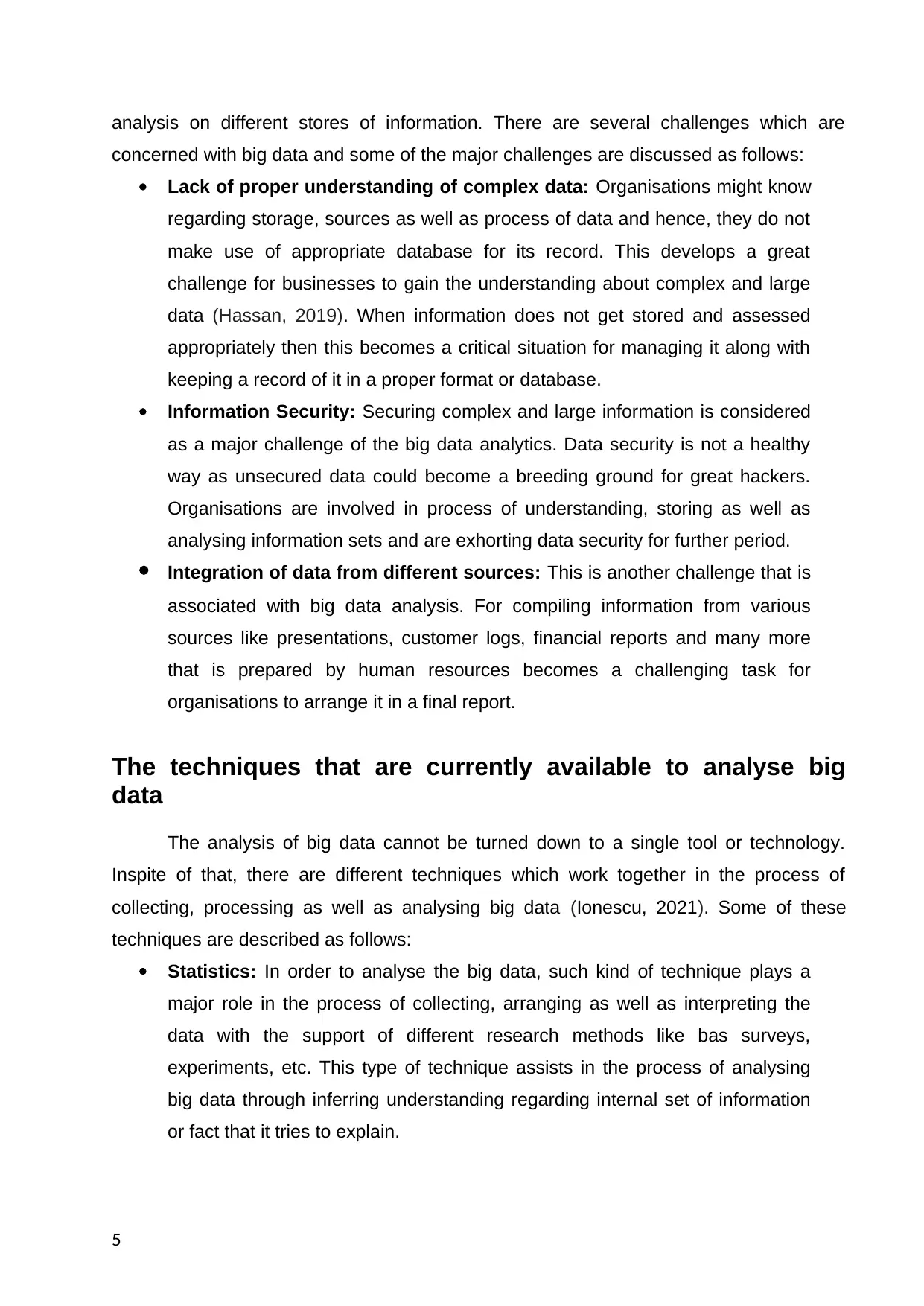
analysis on different stores of information. There are several challenges which are
concerned with big data and some of the major challenges are discussed as follows:
Lack of proper understanding of complex data: Organisations might know
regarding storage, sources as well as process of data and hence, they do not
make use of appropriate database for its record. This develops a great
challenge for businesses to gain the understanding about complex and large
data (Hassan, 2019). When information does not get stored and assessed
appropriately then this becomes a critical situation for managing it along with
keeping a record of it in a proper format or database.
Information Security: Securing complex and large information is considered
as a major challenge of the big data analytics. Data security is not a healthy
way as unsecured data could become a breeding ground for great hackers.
Organisations are involved in process of understanding, storing as well as
analysing information sets and are exhorting data security for further period.
Integration of data from different sources: This is another challenge that is
associated with big data analysis. For compiling information from various
sources like presentations, customer logs, financial reports and many more
that is prepared by human resources becomes a challenging task for
organisations to arrange it in a final report.
The techniques that are currently available to analyse big
data
The analysis of big data cannot be turned down to a single tool or technology.
Inspite of that, there are different techniques which work together in the process of
collecting, processing as well as analysing big data (Ionescu, 2021). Some of these
techniques are described as follows:
Statistics: In order to analyse the big data, such kind of technique plays a
major role in the process of collecting, arranging as well as interpreting the
data with the support of different research methods like bas surveys,
experiments, etc. This type of technique assists in the process of analysing
big data through inferring understanding regarding internal set of information
or fact that it tries to explain.
5
concerned with big data and some of the major challenges are discussed as follows:
Lack of proper understanding of complex data: Organisations might know
regarding storage, sources as well as process of data and hence, they do not
make use of appropriate database for its record. This develops a great
challenge for businesses to gain the understanding about complex and large
data (Hassan, 2019). When information does not get stored and assessed
appropriately then this becomes a critical situation for managing it along with
keeping a record of it in a proper format or database.
Information Security: Securing complex and large information is considered
as a major challenge of the big data analytics. Data security is not a healthy
way as unsecured data could become a breeding ground for great hackers.
Organisations are involved in process of understanding, storing as well as
analysing information sets and are exhorting data security for further period.
Integration of data from different sources: This is another challenge that is
associated with big data analysis. For compiling information from various
sources like presentations, customer logs, financial reports and many more
that is prepared by human resources becomes a challenging task for
organisations to arrange it in a final report.
The techniques that are currently available to analyse big
data
The analysis of big data cannot be turned down to a single tool or technology.
Inspite of that, there are different techniques which work together in the process of
collecting, processing as well as analysing big data (Ionescu, 2021). Some of these
techniques are described as follows:
Statistics: In order to analyse the big data, such kind of technique plays a
major role in the process of collecting, arranging as well as interpreting the
data with the support of different research methods like bas surveys,
experiments, etc. This type of technique assists in the process of analysing
big data through inferring understanding regarding internal set of information
or fact that it tries to explain.
5
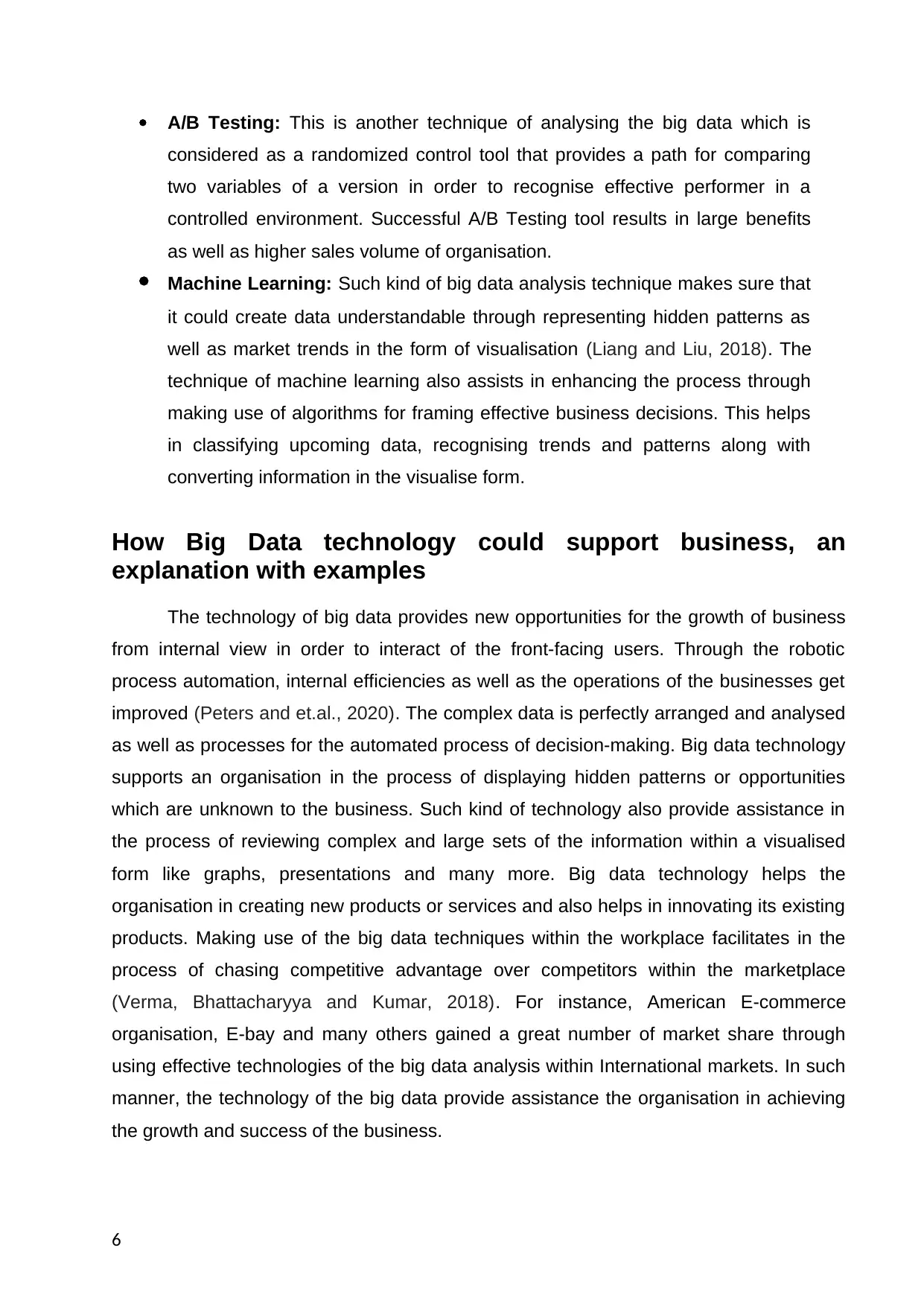
A/B Testing: This is another technique of analysing the big data which is
considered as a randomized control tool that provides a path for comparing
two variables of a version in order to recognise effective performer in a
controlled environment. Successful A/B Testing tool results in large benefits
as well as higher sales volume of organisation.
Machine Learning: Such kind of big data analysis technique makes sure that
it could create data understandable through representing hidden patterns as
well as market trends in the form of visualisation (Liang and Liu, 2018). The
technique of machine learning also assists in enhancing the process through
making use of algorithms for framing effective business decisions. This helps
in classifying upcoming data, recognising trends and patterns along with
converting information in the visualise form.
How Big Data technology could support business, an
explanation with examples
The technology of big data provides new opportunities for the growth of business
from internal view in order to interact of the front-facing users. Through the robotic
process automation, internal efficiencies as well as the operations of the businesses get
improved (Peters and et.al., 2020). The complex data is perfectly arranged and analysed
as well as processes for the automated process of decision-making. Big data technology
supports an organisation in the process of displaying hidden patterns or opportunities
which are unknown to the business. Such kind of technology also provide assistance in
the process of reviewing complex and large sets of the information within a visualised
form like graphs, presentations and many more. Big data technology helps the
organisation in creating new products or services and also helps in innovating its existing
products. Making use of the big data techniques within the workplace facilitates in the
process of chasing competitive advantage over competitors within the marketplace
(Verma, Bhattacharyya and Kumar, 2018). For instance, American E-commerce
organisation, E-bay and many others gained a great number of market share through
using effective technologies of the big data analysis within International markets. In such
manner, the technology of the big data provide assistance the organisation in achieving
the growth and success of the business.
6
considered as a randomized control tool that provides a path for comparing
two variables of a version in order to recognise effective performer in a
controlled environment. Successful A/B Testing tool results in large benefits
as well as higher sales volume of organisation.
Machine Learning: Such kind of big data analysis technique makes sure that
it could create data understandable through representing hidden patterns as
well as market trends in the form of visualisation (Liang and Liu, 2018). The
technique of machine learning also assists in enhancing the process through
making use of algorithms for framing effective business decisions. This helps
in classifying upcoming data, recognising trends and patterns along with
converting information in the visualise form.
How Big Data technology could support business, an
explanation with examples
The technology of big data provides new opportunities for the growth of business
from internal view in order to interact of the front-facing users. Through the robotic
process automation, internal efficiencies as well as the operations of the businesses get
improved (Peters and et.al., 2020). The complex data is perfectly arranged and analysed
as well as processes for the automated process of decision-making. Big data technology
supports an organisation in the process of displaying hidden patterns or opportunities
which are unknown to the business. Such kind of technology also provide assistance in
the process of reviewing complex and large sets of the information within a visualised
form like graphs, presentations and many more. Big data technology helps the
organisation in creating new products or services and also helps in innovating its existing
products. Making use of the big data techniques within the workplace facilitates in the
process of chasing competitive advantage over competitors within the marketplace
(Verma, Bhattacharyya and Kumar, 2018). For instance, American E-commerce
organisation, E-bay and many others gained a great number of market share through
using effective technologies of the big data analysis within International markets. In such
manner, the technology of the big data provide assistance the organisation in achieving
the growth and success of the business.
6
⊘ This is a preview!⊘
Do you want full access?
Subscribe today to unlock all pages.

Trusted by 1+ million students worldwide
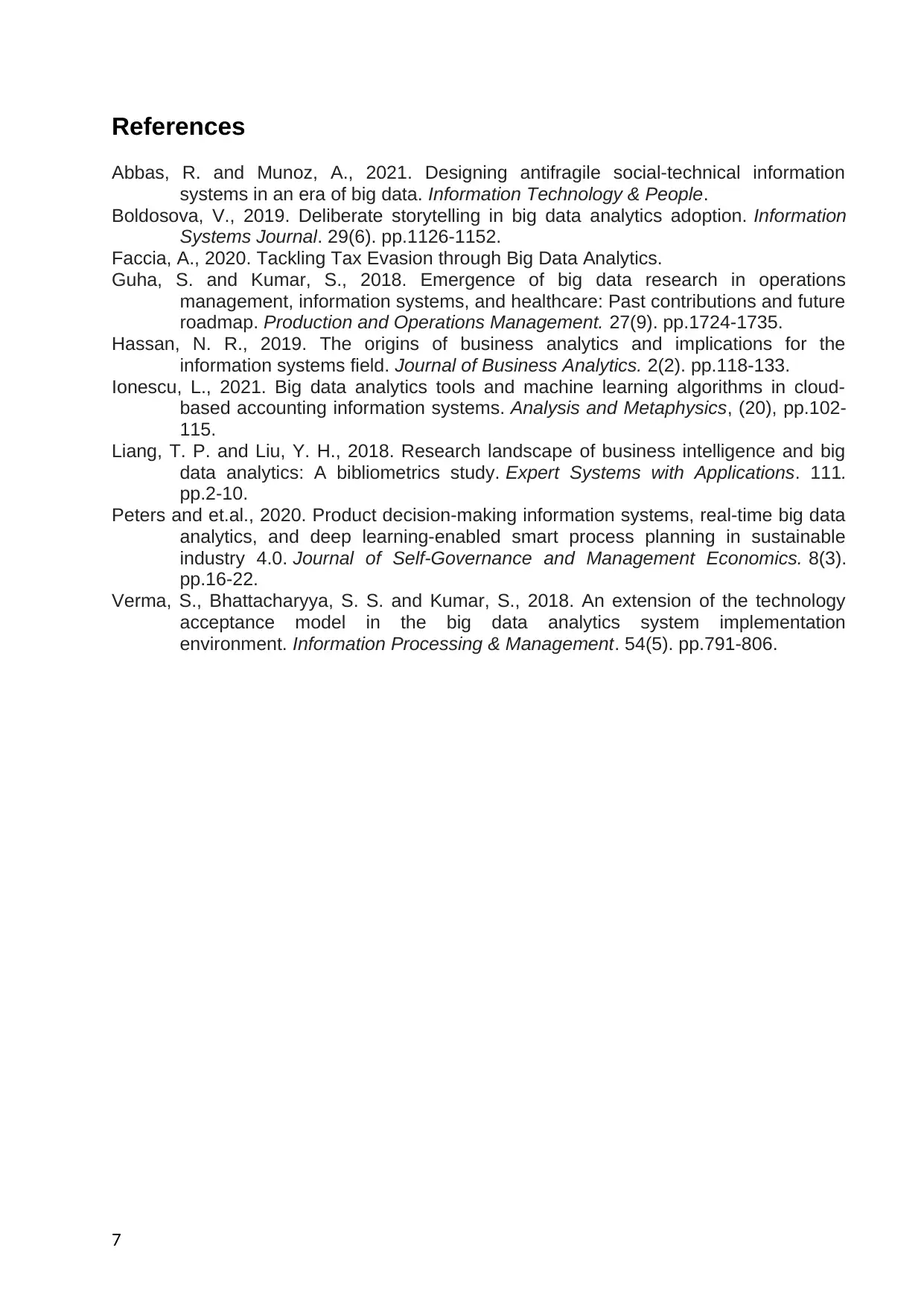
References
Abbas, R. and Munoz, A., 2021. Designing antifragile social-technical information
systems in an era of big data. Information Technology & People.
Boldosova, V., 2019. Deliberate storytelling in big data analytics adoption. Information
Systems Journal. 29(6). pp.1126-1152.
Faccia, A., 2020. Tackling Tax Evasion through Big Data Analytics.
Guha, S. and Kumar, S., 2018. Emergence of big data research in operations
management, information systems, and healthcare: Past contributions and future
roadmap. Production and Operations Management. 27(9). pp.1724-1735.
Hassan, N. R., 2019. The origins of business analytics and implications for the
information systems field. Journal of Business Analytics. 2(2). pp.118-133.
Ionescu, L., 2021. Big data analytics tools and machine learning algorithms in cloud-
based accounting information systems. Analysis and Metaphysics, (20), pp.102-
115.
Liang, T. P. and Liu, Y. H., 2018. Research landscape of business intelligence and big
data analytics: A bibliometrics study. Expert Systems with Applications. 111.
pp.2-10.
Peters and et.al., 2020. Product decision-making information systems, real-time big data
analytics, and deep learning-enabled smart process planning in sustainable
industry 4.0. Journal of Self-Governance and Management Economics. 8(3).
pp.16-22.
Verma, S., Bhattacharyya, S. S. and Kumar, S., 2018. An extension of the technology
acceptance model in the big data analytics system implementation
environment. Information Processing & Management. 54(5). pp.791-806.
7
Abbas, R. and Munoz, A., 2021. Designing antifragile social-technical information
systems in an era of big data. Information Technology & People.
Boldosova, V., 2019. Deliberate storytelling in big data analytics adoption. Information
Systems Journal. 29(6). pp.1126-1152.
Faccia, A., 2020. Tackling Tax Evasion through Big Data Analytics.
Guha, S. and Kumar, S., 2018. Emergence of big data research in operations
management, information systems, and healthcare: Past contributions and future
roadmap. Production and Operations Management. 27(9). pp.1724-1735.
Hassan, N. R., 2019. The origins of business analytics and implications for the
information systems field. Journal of Business Analytics. 2(2). pp.118-133.
Ionescu, L., 2021. Big data analytics tools and machine learning algorithms in cloud-
based accounting information systems. Analysis and Metaphysics, (20), pp.102-
115.
Liang, T. P. and Liu, Y. H., 2018. Research landscape of business intelligence and big
data analytics: A bibliometrics study. Expert Systems with Applications. 111.
pp.2-10.
Peters and et.al., 2020. Product decision-making information systems, real-time big data
analytics, and deep learning-enabled smart process planning in sustainable
industry 4.0. Journal of Self-Governance and Management Economics. 8(3).
pp.16-22.
Verma, S., Bhattacharyya, S. S. and Kumar, S., 2018. An extension of the technology
acceptance model in the big data analytics system implementation
environment. Information Processing & Management. 54(5). pp.791-806.
7
Paraphrase This Document
Need a fresh take? Get an instant paraphrase of this document with our AI Paraphraser

Appendix 1: Poster
8
8
1 out of 8
Related Documents
Your All-in-One AI-Powered Toolkit for Academic Success.
+13062052269
info@desklib.com
Available 24*7 on WhatsApp / Email
![[object Object]](/_next/static/media/star-bottom.7253800d.svg)
Unlock your academic potential
Copyright © 2020–2025 A2Z Services. All Rights Reserved. Developed and managed by ZUCOL.

